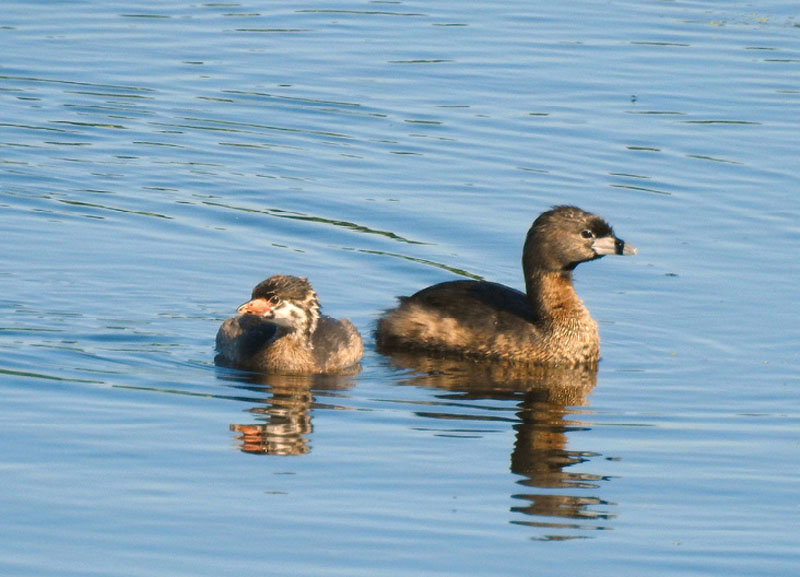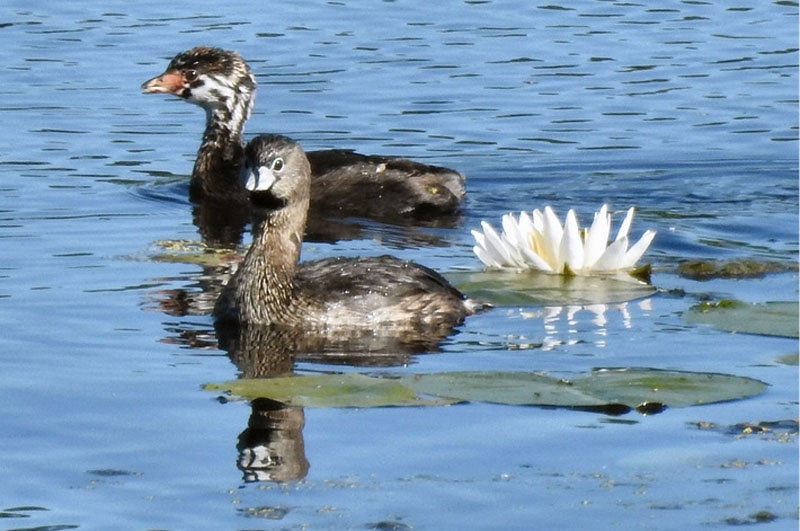Carolyn Longworth

Pied-billed Grebe chick with parent. All photographs by the author.
As a beginning birder, I was excited just to checklist the small, brown, nondescript Pied-billed Grebe listed as endangered in Massachusetts, let alone have the opportunity to watch a family of grebes all summer in 2017 at Egypt Lane Ponds in Fairhaven, Massachusetts.
Egypt Lane Ponds was formerly part of the dumping ground for the processing effluents of Atlas Tack Corporation. The plant was built in 1901 and manufactured wire tacks and steel nails until 1985. The plant discharged wastes that contained cyanide and heavy metals, which contaminated soil, groundwater, and nearby wetlands. It became a US Environmental Protection Agency (EPA) Superfund Site in 1990. Site cleanup occurred between 2005 and 2007, and long-term monitoring is ongoing (EPA 2017). In the 1960s, a hurricane dike was built that split the salt marsh and interrupted the flow of the creek from the bay, creating a pond from some freshwater streams on the north side of the dike. The $20 million Superfund cleanup created just the spot for birds of freshwater and salt marshes.
Sitting on the hurricane dike on a warm spring evening several years ago, my birding companions and I heard a loud cow-cow-cow sound that baffled us. Fortunately Pied-billed Grebes are at the beginning of the bird song CDs, so we quickly identified it.
In the spring and summer of 2014 and 2015, several birders saw and heard an adult Pied-billed Grebe throughout the summer. In 2016, birders heard the grebe in late spring and someone said another birder had seen chicks. But Egypt Lane Ponds was only one stop on our birding route and we didn’t put in a lot of time.
In April 2017, fellow birders Dan Logan, Dan Mackinnon, and I decided to focus on the pond and visit once or twice a day. We heard a single grebe calling, but in May we heard duetting. At first we’d see only one, but the unseen bird was always in the same spot farther out on the pond. In late May, we saw the pair—their wings extended—steam after a muskrat that had gotten too close to the nest. Later, there were frequent surreptitious food deliveries and on June 4, with the aid of a scope, we saw the nest and two tiny orange heads.

Pied-billed Grebe chick with parent.
Three days later, the adults swam out together. One rose up, fluffed its feathers, and three chicks fell out. Soon the tiny striped babies were doing many classic grebe moves: diving, eating a feather, and riding on a parent’s back. The attending parent made sure all the babies were fed. Any time a duck swam toward the new arrivals, one of the parents, wings akimbo, would sail out in pursuit.
A few weeks later only two chicks were left. We saw one adult and heard the other calling from the nest area. We hoped that it was a sign of a second nesting attempt. However, we never saw the adult again and the calls stopped, leading us to believe that the grebes were victims of predators. A family of five cygnets and two adult swans met with a similar disaster and we had seen coyotes in the area. We had also seen mink, river otters, snapping turtles, fishers, and herons.
The surviving chicks were fun to watch as they practiced aggressive and evasive behavior and learned to get their own food. Once they were able to skitter along the water, the parent sometimes had a hard time finding them to feed them fish and frogs.
Often the chicks would swim around a couple of Mallards sunning on a rock. They did the sudden sinking and the show of circling with wings held high. The Mallards ignored the chicks. However, when the smaller, more aggressive chick submerged and headed toward a cygnet, the adult swan chased the chick away.
When the grebes were alarmed, they stretched their necks out very tall. One time, a dozen Canada Geese landed in the pond and the grebe chicks quickly swam into their midst, looking like Viking ships. The grebes, by means of diving, rippling, and touching the geese from underwater, managed to herd them to the other side of the pond. The larger chick then joined the adult to snooze, while the smaller one displayed another classic grebe move, the crash dive, suddenly submerging while kicking up a big splash of water several feet high.
By August, the chicks’ stripes and orange bits were faded. Weeks later, it was hard to tell the adult from the chicks at a distance. The parent’s bill stripe was fading too. Even rainy days provided good views of the family tucked into the porkpie position in the lily pads. They also folded their legs up, so that they looked like rowboats with the oars shipped.
In September, the grebes’ territorial behavior on the pond ceased. Mallards no longer avoided the grebes, but headed straight for them, making them give way. We even saw young Wood Ducks lunging at grebes.
Looking back over old photos, I realized that we had seen small groups of grebes in the fall in previous years and they may have been born at Egypt Lane Ponds. One group of three immatures had stripey heads in October of 2011.
It was hard paying whole-hearted attention to the grebes this past spring and summer with two clutches of Clapper Rails, a visiting King Rail, a Common Gallinule, and Least and American bitterns also putting on a show, not to mention groups of birders gazing into the marsh. I learned the value of reading, listening to other birders, and spending hours of observation.
In short, 2017 gave us a good opportunity to see the value of the transformation of a lagoon filled with cyanide and heavy metals into a breeding spot for interesting and endangered birds through the efforts of state, local, and federal funding.
Reference
Carolyn Longworth has been a librarian in Fairhaven for over 40 years and a birder for about 15 years. Website at http://bvm1290.blogspot.com/p/blog-page.html